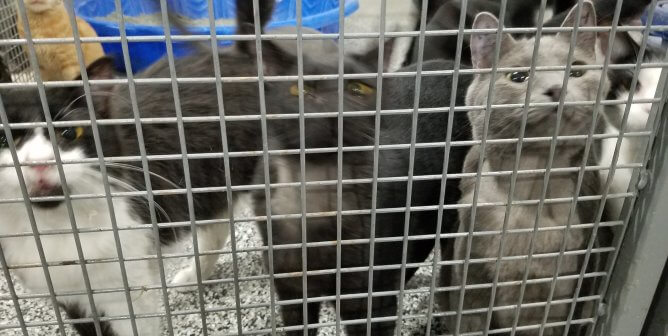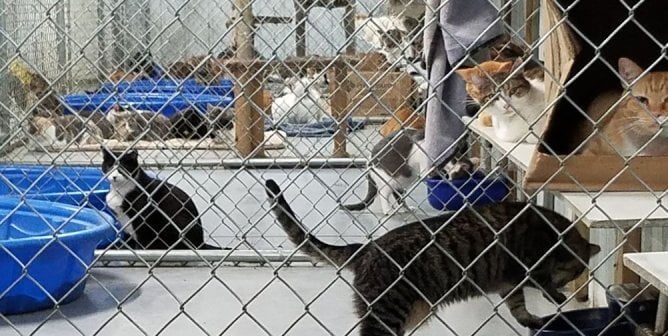Living with Allergies to Animals
People who suffer from allergies to cats, dogs, or other animals may be advised by well-intentioned doctors to find new homes for their companion animals, but doctors are increasingly recognizing the importance of the human-animal bond. Says one California allergist, “If the advice to give up their pets is handed down … most people change allergists rather than change pets.”(1) There are many ways to increase the chances that your allergies and your animal companion can peacefully coexist.
What Causes Allergic Reactions?
Allergy-causing substances (allergens) can be found in animals’ hair, dander, urine, feces, and saliva. They can be carried on clothes and can stay in carpets and furniture for months, even after an animal no longer lives there.(2) The Journal of Allergy and Clinical Immunology reported that dog and cat allergens are detectable in 100 percent of U.S. homes.(3)
Despite some claims, there are no allergen-free cats or dogs. Dr. Kerry Hancock, who is with the National Asthma Council Australia, says, “All cats are going to shed hair (containing allergens), whether they’re long or short-haired. The allergen is the same across all cat breeds,” although allergy-causing proteins may be higher in male cats than female, and neutering a male cat might decrease allergic reactions.(4,5) As for canine companions, don’t let all the hype about labradoodles and other so-called “hypoallergenic breeds” keep you from adopting a mutt. The American Academy of Allergy, Asthma and Immunology states, “No dog is 100% hypoallergenic. Even hairless dogs produce some allergens.”(6) Dogs with short hair or those who shed less might give their guardians fewer allergy problems.
Even exposure to rats, mice, rabbits, and horses can cause an allergic reaction.(7) Regardless of breed, allergy-sufferers who are considering adopting an animal should spend time with each prospective animal individually to see if a reaction develops.
Reducing Allergies in Childhood
Early childhood exposure to cats, dogs, and other animals has been shown to lower the risk of developing allergic reactions later in life. One study of more than 800 children in Switzerland found an inverse relationship between contact with dogs and diagnoses of hay fever and asthma, whereas children who had “early and current contact with cats were associated with reduced risk of wheezing and grass pollen sensitization.”(8) Another study of more than 8,000 children, ages 5 to 7, determined that those who had been continuously exposed to cats from the time that they were 1 year old were 67 percent less likely than other children to develop allergic asthma.(9) In some countries where cat companionship is high, epidemiological studies have shown a relatively low prevalence of cat allergies.(10)
Medication May Be a Solution
New medications can make living with allergies much more comfortable. A wide variety of nasal sprays, antihistamines, decongestants, and inhalers can help control allergy symptoms. Immunotherapy is composed of a series of shots given over time that can help desensitize you to allergens. Your allergist can help you choose the right plan for you.
Certain nutritional supplements and herbs can also help to minimize an allergic response, including vitamins A, B6, C, and E; bioflavonoids such as citrin; flaxseed oil, which contains omega-3 fatty acids; MSM (methylsulfonylmethane); and the herbs stinging nettles, grapeseed extract, and ginkgo.(11) Check with a holistic health-care practitioner for more information.
What You Can Do
First, be sure that it really is your animal who is provoking your allergic reaction. If you’re allergic to an animal, you are probably allergic to other things as well. By decreasing other irritants, you’ll reduce your overall symptoms. Avoid tobacco smoke, automobile exhaust, and other irritants that can inflame your airways. The following are some other suggestions for decreasing symptoms from allergies to animals:
- Buy inexpensive vinyl encasing for mattresses and box springs, and minimize upholstered furniture. Wash walls, ceilings, blankets, curtains, and throw pillows regularly. (The main reservoirs of cat allergens are carpets, drapes, upholstered furniture, mattresses, walls, and ceilings, which catch dust and dander.)
- Replace carpets with tile, hardwood flooring, linoleum, or rugs that can be washed, especially in rooms where you spend a lot of time, such as the bedroom. If you must have carpets, spray them with a product that contains nontoxic tannic acid, which helps combat the effects of cat allergens.
- Use a high-efficiency particulate air (HEPA)-type vacuum—it will capture the small particles of allergens that conventional paper-filter vacuums cannot. Consider getting a HEPA-filter room air-cleaner, which removes almost 100 percent of allergenic particles. Free-standing cleaners are better than the small, table-top filters. Remember to replace the filters often.
- Provide your animal companions with their own comfortable beds and blankets.
- Always wash your hands after petting your animal companions.
- If possible, have others groom and bathe your animals and clean the litterbox. Grooming should be done in a well-ventilated area.
- Beware of dusty or deodorized cat litter, which can be as allergenic as the cat.
- Keep ducts, furnaces, and air conditioner filters clean.
- Ventilate your house. Circulate air in the house by opening windows every day.
- Feed your animal a high-quality diet that includes omega-3 fatty acids; healthy animals produce less dander.
- Be thorough in cleaning—search out dust, mold, and animal hair.
- Minimize or eliminate your consumption of common allergenic foods. In one study, 15 of 22 patients with asthma enjoyed improved health after only a couple of weeks of avoiding all dairy “products.” (12)
Resources
Sources of allergy control devices and supplies:
- Allergy Control Products: 1-800-422-DUST
- National Allergy Supply: 1-800-522-1448
References
1) Melissa Schoor, “A Dog, a Cat, Achoo! Pets Not Sacrificial Lambs to Allergies,” Alameda Times-Star 13 Apr. 2004.
2) Karen Youso, “Improve It; HG Fixit; Cat Allergy Got Your Dander Up? Go for Clean Sweep,” Star Tribune 16 Mar. 2005.
3) J. Mehta et al., “Dog Allergen (Can f 1) and Cat Allergen (Fel d 1) in U.S. Homes” Journal of Allergy and Clinical Immunology 113 (2004): S229.
4) Daniel Brettig, “Living With That Loving Feline,” The Advertiser 12 Mar. 2004.
5) Lawrence G. Proulx, “When You’re Allergic to the One You Love,” The Washington Post 23 Dec. 1997.
6) American Academy of Allergy, Asthma & Immunology, “The Truth About Pet Allergies,” Elements of Allergy and Asthma Jun. 2009.
7) Morris Nejat, M.D., “Pet Allergies,” Connecticut Post 28 May 2004.
8) M. Waser et al., “Exposure to Pets, and the Association With Hay Fever, Asthma, and Atopic Sensitization in Rural Children,” Allergy 60 (2005): 177-84.
9) “Growing Up With Cats Good for Allergies,” Reuters, 3 Nov. 2003.
10) G. Liccardi et al., “The Effect of Pet Ownership on the Risk of Allergic Sensitization and Bronchial Asthma,” Respiratory Medicine 99 (2005): 227-33.
11) Stephen Langer, “Take Control of Allergies and Asthma,” Better Nutrition 60 (1998): 34-8.
12) Langer.







